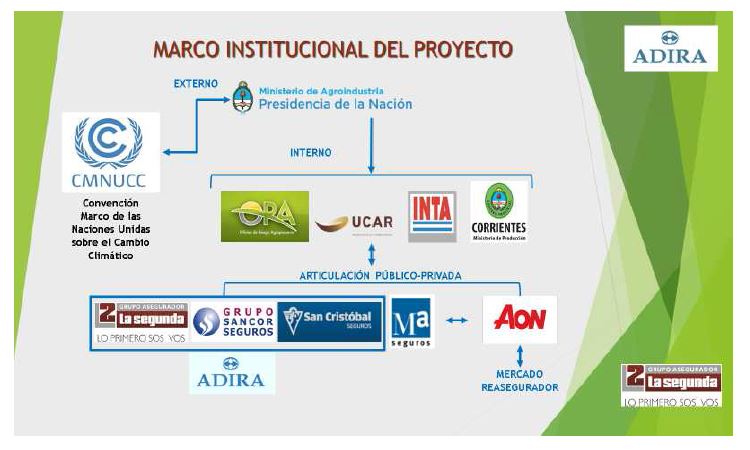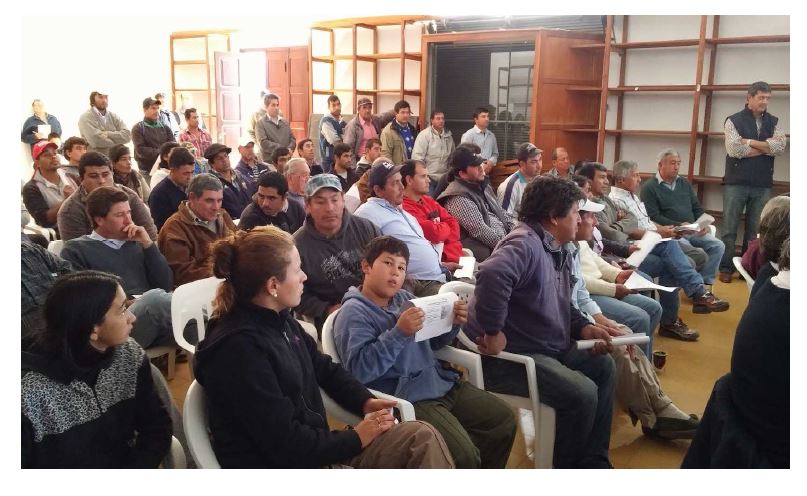Author: Ing. Agr. Santiago Cabral
Grupo Asegurador La Segunda-Febrero 2019
It has been a few years since the Argentine insurance system intends to overcome the barrier of extensive granary crops and does not achieve it, or only does so in moderate experiences.
However, during the 2016-2018 campaigns a completely new pilot test was carried out, which emphasized, not only in a different production system, but fundamentally, on a segment of the farmers that had not yet been accessed.
The “Project of Adaptation and Resilience of Family Farming in Northeast Argentina in view of the impact of Climate Change and its Variability” began in October 2013, through a donation from the United Nations Climate Change Adaptation Fund, arising from the Kyoto Protocol to the United Nations Framework Convention on Climate Change (UNFCCC). This Project was implemented on three main areas of intervention, which outlined activities to be carried out within which, the development of insurance coverage was one of them.
Axes of intervention and activities
1- Increase in the ability of small family producers to adapt to climate variability
- Implementation of improvements in the efficiency of use, collection, harvesting and storage of water.
- Implementation of a risk management and transfer system for small and medium producers.
- Optimization practices of agricultural, livestock and forestry productive management.
2- Strengthening of information systems, monitoring and management of climate information
- Integration and expansion of agro-hydro-meteorological networks.
- Development of an Early Warning System to assess and manage climate risks, including extreme events.
3- Generation of local and regional capacities for decision-making and adaptation actions to climate change
- Development of training and communication modules on risk management and transfer for government technical experts and family producers.
- Training for provincial units for the management and monitoring of hydro-meteorological data, analysis of climate information, use of tools and development of adaptation modules.
The General Project was delimited in the geographical area called Northeast Argentina (NEA), and included the center-south of the province of Chaco, the north of Santa Fe, the west of Corrientes and the east of Santiago del Estero, while the The Insurance Project began with four departments in the west of the province of Corrientes 2, to be expanded in a second phase to four more departments in that province and three departments in the northeast of Santa Fe.
The institutional articulation was coordinated by the Office of Agricultural Risks (ORA), under the former Ministry of Agriculture of the Nation, which had the difficult mission of leading the first sketches of ideas taken to the work table, towards the development of a Unpublished common project in its route and conception. In this way, the final product launched and the successive corrections implemented in the second phase, turned out to be the result of collective work contributed by public institutions such as the Rural Change Unit (UCAR), the National Institute of Agricultural Technology (INTA) and the Ministry of Production of the Province of Corrientes, as well as private institutions such as the La Segunda Insurance Group, the Sancor Seguros Group and San Cristóbal Seguros, combined and represented by the entity that groups them as Interior Insurers of the Argentine Republic (ADIRA). They were joined by a fourth insurer, Mercantil Andina, and the contribution of the AON Reinsurance Broker was invaluable, not only in facilitating the accompaniment of the main referents of the reinsurance market, but fundamentally, in the resolution of the technical complexities that they challenged the pricing model for the risks to be taken into account. Special mention deserves the arduous analytical work carried out on the basis of information from the Agricultural Emergency Decrees of the Province of Corrientes, together with journalistic information of the related events, as well as the Climate Registries of the Regional Meteorological Stations and of the INTA Production Tests.
IMAGE N°1. Institutional Articulation Framework

2 Bella Vista, Goya, Lavalle, San Roque
The final product obtained, “Insurance for crops under greenhouse”, was formalized in front of the Superintendence of National Insurance (SSN) on August 3, 2016 through File No. 0022985/2016, Provided No. 123106, and its processing took two great virtues regarding similar previous experiences. First, although the coverage was initially directed to two specific crops under cover, namely tomato and pepper, authorization was extended for all crops; and secondly, although the test would be carried out in a bounded geographical region as described above, the validation was extended throughout the national territory, thus consolidating the generation of an instrument of greater amplitude, than at The future could be useful for other productive regions, and even for other productive systems.
Another finding or novelty was focused on the fact that for the first time for the Agricultural and Forest Risks Branch, the coverage of a complementary good within the productive system to the crops themselves was considered, which in this case turned out to be plastics of roof of the greenhouses. It is important to mean the relative value of the region chosen to test the launch, taking into account that the province of Corrientes is one of the most important in terms of horticultural production under cover, representing 56% of the national total. Similarly, the crops selected for launching accounted for 18% of the national production in terms of tomato, and 44% of the same for the case of pepper, standing out especially within this powerful regional economy, the horticultural conglomerate of the towns of Bella Vista and Santa Lucia.
PHOTO N ° 1. Presentation of the coverage in the Cooperativa de Santa Lucía

We mentioned at the beginning the direction of the project towards “a segment of the farmers that had not yet been accessed” with agricultural insurance in Argentina, and this happened because the established scale threshold was limited to small producers whose cultivated area did not exceed one hectare Likewise, we also expressed at the beginning of the challenge of “overcoming the barrier of extensive granary crops”, to which we should add, the structural challenge of overcoming the barrier of hail risk, so that we can consider the extension to wind as another success, Fire and frost.
The Project was implemented in two phases, and although the design of the coverage considered an annual period of validity between February 1 of a year and January 31 of the following year, including coverage at least for the structure still in the Time of the year when there were no crops under these, inconveniences in the dynamics of the different formal processes involved prevented this from being achieved. This is how, the first policy was valid from August 1, 2016 until January 31, 2017, and the second policy was effective from April 05, 2017 until January 31, 2018.
The Insurance Group The Second was in charge of the operation pilot and the responsibility of driving in territory, the fulfillment of the commitments assumed among so many actors involved with great passion to the development of an innovation with claims of high social and cultural impact. There was an administrative assembly aimed at satisfying the requirements of the issuance of the policy, the certification of coverage for the beneficiaries and the attention of claims of claims, and an evaluation site was formed that added other good news for the novelty in the sector: incorporation of women’s professional contribution to the field.
PHOTO N ° 2. Creation of the claims assessment site

The comparative analysis between the two phases of the implementation process marks progress in every way, and reaffirms the importance of continuity in this type of undertakings. First, phase 1 had 6 effective months of coverage, while phase two had 10 effective months. Secondly, phase 1 was developed exclusively on four departments of the province of Corrientes: Bella Vista, Goya, Lavalle and San Roque; while phase 2, it was dispersed over a total of eleven departments, adding to the original four, four more from the same province: Capital, Empedrado, San Luis del Palmar and San Cosme; and three more from the neighboring province of Santa Fe: General Obligado, Vera and San Javier. Thirdly, it was passed from just two crops, tomato and pepper, to all the crops that the farmers had implanted under their hothouses, thus appearing on the scene other vegetables such as chard, basil, eggplant, scallion, chaucha , lettuce, cucumber, parsley, arugula or zucchini. Likewise, the list could be continued with the number of beneficiaries extended between one phase and another from 577 to 666, the total protected area that went from 215 to 277 hectares, the total insured sum exposed to risk of 20 million pesos rose to 43 million pesos, or the number of complaints addressed that of 143 rose to 391.
Another novelty that incorporated the project in its second section was the segmentation of the beneficiaries into two strata, to allow a greater insured sum on roofing plastics of greenhouses, in those cases of very small producers of up to five tents. In addition, the learning obtained in phase 1 led to the modification of the methodology for the evaluation of claims that had been developed in parallel, without verifying the effective replacement of plastics and establishing a fixed affectation threshold, from which to consider the carp as damaged. This simple but effective measure made it possible to anticipate the payment of compensation, in those sinister situations in which the time of occurrence did not merit an immediate replacement of the roofs.
PICTURE N ° 2. Geographic Expansion of the Pilot Test

The route taken allows us to affirm that the challenge was successfully resolved. The tool obtained had to overcome in its design a series of external difficulties for all those who integrated the work table and brought in our background of experience the logic of the granary extensive crops. It was very stimulating to find technical solutions to the composition of the sum insured in the case of crops that do not interrupt the collection of their produce at the same time. This is how the complexity of the crop advance curves, variable according to species and variety, changing according to sowing dates and marketing strategies, could be solved by means of a downward modeling in which one of the essential objectives set by the production team prevailed. I initially work for this and other projects under consideration, which was that of simplicity, in the context of analysis scenarios characterized by the absence of consistent and robust databases.
It is valid to note the existence of a previous immediate antecedent carried out in 2007, in which horticultural and floricultural producers of the province of Corrientes, adherent to the then “Rural Development Project of the Northeast Argentine Provinces” (PRODERNEA) , were beneficiaries of an incipient experience that covered an area of 12.8 hectares. A new step is then added, much more ambitious as the numbers show, to a road whose all reason leads to unveiling that should not be interrupted, and should even encourage other ideas, since the inertia of the initial movement was overcome with satisfaction, and the Over the years and walking should provide the necessary growth and enrichment opportunities so that in the not too distant future, we can proudly say that the Argentine model of agroseguros, so rich in history and penetration, has understood and adopted the visions of the UN, the highest international diplomacy body, in terms of the importance and intimate relationship between the planet’s food and family farming
PHOTO N ° 3. Typical accident situation of wind damage in roof plastics





Comments are closed.